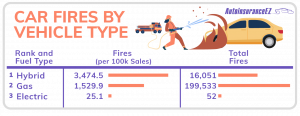Much publicity has been given to the rare instances of EVs catching fire – especially the widely reported fires experienced in Tesla Model S vehicles. These particular fires resulted from the battery pack being penetrated by road debris which resulted in fires some time after the event – they were not explosive events and no one was injured. Tesla has made improvements to battery shielding in the form of a titanium under-body shield consisting of 1/4 inch ballistic grade aluminium armor plate protecting the battery.
When one considers the amount of conventional (internal combustion engine fires) the number of EV fires pales in comparison. It must be remembered that no type of car is ‘safe’ – for example a cup of petrol when mixed with air has enough explosive power to destroy a house or car.
To put things in perspective the estimated number of vehicle fires in the US from 2014 – 2016 was 171,500 each year or 19.5 automobile fires on average each hour! These fires resulted in an annual average of 345 deaths; 1,300 injuries; and $1.1 billion in property loss.
Now data is emerging from those with the greatest financial interest on EV v ICE fires, the insurance sector. In recent data (2021) from National Transportation Safety Board (NTSB), Bureau of Transportation Statistics (BTS), and government recall data from Recalls.gov, insurance company AutoinsuranceEZ has determined EVs are by far the least likely to have fires from the vehicle types of Hybrid (the most fires per 100k sales) ICE (second most) and EVs (the least). There are 60 times as many fires in ICE fires per 100k sales than EV fires. The following graphic gives the actual figures (2021) from the agencies listed:


Leave A Comment